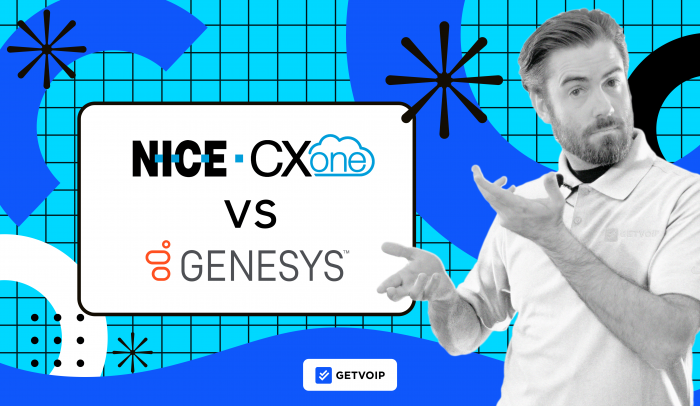Genesys Cloud and NICE CXone are two of the most popular omnichannel contact center and customer experience platforms on the market today–but which one best meets your business needs?
In this post, we outline the key differences between Genesys Cloud and NICE CXone, comparing available pricing and plans, WFM features, communication channels, integrations, analytics, overall user experience, and more.
NICE CXOne vs Genesys Cloud: Our Take
NICE CXone is best for:
- Teams needing advanced, AI-powered WFM solutions to improve CSAT and agent performance
- Enterprise digital-first contact centers that communicate with a high volume of daily customer interactions across multiple social media platforms
- Global contact centers that need to identify opportunities for fully automated customer service without sacrificing personalization, especially via predictive routing
Genesys is best for:
- Teams needing built-in UCaaS features like video calling, chat messaging, and file sharing
- Enterprise sales teams focused on automating outbound customer engagement across voice and digital channels to increase conversions, upselling, and cross-selling opportunities
- Contact centers with advanced third-party integration needs
NICE CXOne vs Genesys Cloud: Quick Comparison
NICE CXone is an enterprise cloud contact center and customer experience platform powered by Enlighten AI. A 9-time Gartner Magic Quadrant CCaaS leader, NICE leverages purpose-built AI to support and engage customers across voice and digital channels, empower agents in real-time, and optimize contact center operations.
Genesys Cloud is an all-in-one customer engagement, workforce management, and omnichannel contact center platform using AI to orchestrate personalized customer and agent experiences. Named as a Forrester Wave Leader in the contact center space, Genesys Cloud is trusted by 8,000 organizations in over 100 countries.
| NICE CXOne | Genesys | |
| Best For |
|
|
| Pricing+Plans |
|
|
| Key Voice Calling Features |
|
|
| Digital Communication Channels |
|
|
| Key QM+WFM Features |
|
|
| Analytics+Reporting |
|
|
| Integrations |
|
|
| Reliability+Security |
|
|
| Customer Support |
|
|
NICE CXone vs Genesys: Pricing and Plans
Key Takeaway: While NICE CXone is more expensive than Genesys, it has a longer free trial period. Although NICE and Genesys market their AI-powered features as the foundation of all contact center operations, both providers hide the fact that many of these features are accessible only via paid add-ons–even on the most expensive plans.
NICE CXone Pricing
NICE CXone includes 6 paid plans from $71-$209/agent/month, 6 quote-based add-on packages, and a 60-day free trial.
While the three plans in the “Interactions Orchestration” pricing tier are more affordable, they include only basic interaction management and reporting tools ideal for small, in-house contact centers. The three plans in the “Orchestration, Optimization, and Analytics” tier are more expensive, but meet the needs of enterprise omnichannel contact centers that require advanced performance monitoring and workforce management tools.
NICE’s Interaction Orchestration Plans are:
- Digital Agent Plan ($71/agent/month): 30+ digital communication channels (no voice calling), dedicated supervisor and agent workspaces, basic reporting, digital recording+storage
- Voice Agent Plan ($94/agent/month): Voice calling only (no digital channels), voice recording+storage, no-code IVR, call queuing with concurrent interaction management
- Omnichannel Agent Plan ($110/agent/month): Voice+digital channels with blended interaction routing and universal queues
NICE’s Orchestration, Optimization, and Analytics Plans are:
- Essential Suite ($135/agent/month): Omnichannel Agent Plan plus voice+digital interaction recording, agent screen recording, basic quality management tools
- Core Suite ($169/agent/month): Adds Workforce Management features (omnichannel forecasting+scheduling, adherence monitoring) and Performance Management features (wallboards, near real-time agent monitoring)
- Complete Suite: ($209/agent/month): Adds Feedback Management features (CSAT monitoring, omnichannel surveys) and Interaction Analytics (AI sentiment and root cause analysis, speech+text analytics)
NICE CXone add-ons include CXone Expert and Guide; Enlighten Autopilot, Copilot, and AI routing; and a Proactive Dialer. For more details, check out our complete guide to NICE CXone pricing and plans.
Genesys Cloud Pricing
Genesys Cloud offers 5 plans from $75-$155/agent/month, 3 main add-ons, and a 14-day free trial.
The Genesys Cloud 1 tier is a voice-only platform ideal for small-to-medium-sized call centers. The Genesys Cloud 2 tier, best for SMBs prioritizing scalability, lets users choose between an omnichannel and digital-only contact center plan. The Genesys Cloud 3 tier for enterprise-level contact centers includes 1 omnichannel CCaaS plan with Workforce Engagement Management features and 1 digital-only plan with WEM tools.
Available Genesys Cloud plans are:
- Genesys Cloud 1 Voice Plan ($75/agent/month): Voice calling only (no digital communication channels), automated callbacks, IVR/ACD, interaction/screen recording, outbound campaigns, collaboration tools, real-time/historical reporting
- Genesys Cloud 2 Digital Plan ($95/agent/month): Digital communication only (no voice calling), quality management tools, agent evaluations, internal knowledge base, interaction monitoring/recording
- Genesys Cloud 2 Digital+Voice Plan ($115/agent/month): Voice and digital communication channels, interaction analytics, omnichannel routing, workflow design tool
- Genesys Cloud 3 Digital+WEM Plan ($135/agent/month): Digital communication channels only, agent activity monitoring/scoring, leaderboards, AI scheduling/forecasting, gamification, shift trading, voice of the customer analytics, agent coaching
- Genesys Cloud 3 Digital+Voice+WEM Plan ($155/agent/month): Voice and digital communication channels, AI speech and text analytics, advanced workforce engagement tools
Available Genesys Cloud add-ons include Genesys Cloud EX, PointillistⓇ by Genesys, and AI Experience. For more details, see our complete Genesys pricing guide.
NICE CXone vs Genesys Cloud: Feature Comparison
Below, we compare Genesys Cloud vs NICE CXone customer engagement, WFM, Agent Assist, and analytics features.
Customer Engagement
Key Takeaway: NICE and Genesys customer engagement features facilitate inbound/outbound omnichannel communication between customers and live agents, customers and intelligent virtual agents, and a mixture of the two. Both platforms offer omnichannel proactive customer engagement via outbound auto dialers, predictive website chat messaging, and outbound email/SMS marketing to free up live agents and increase productivity.
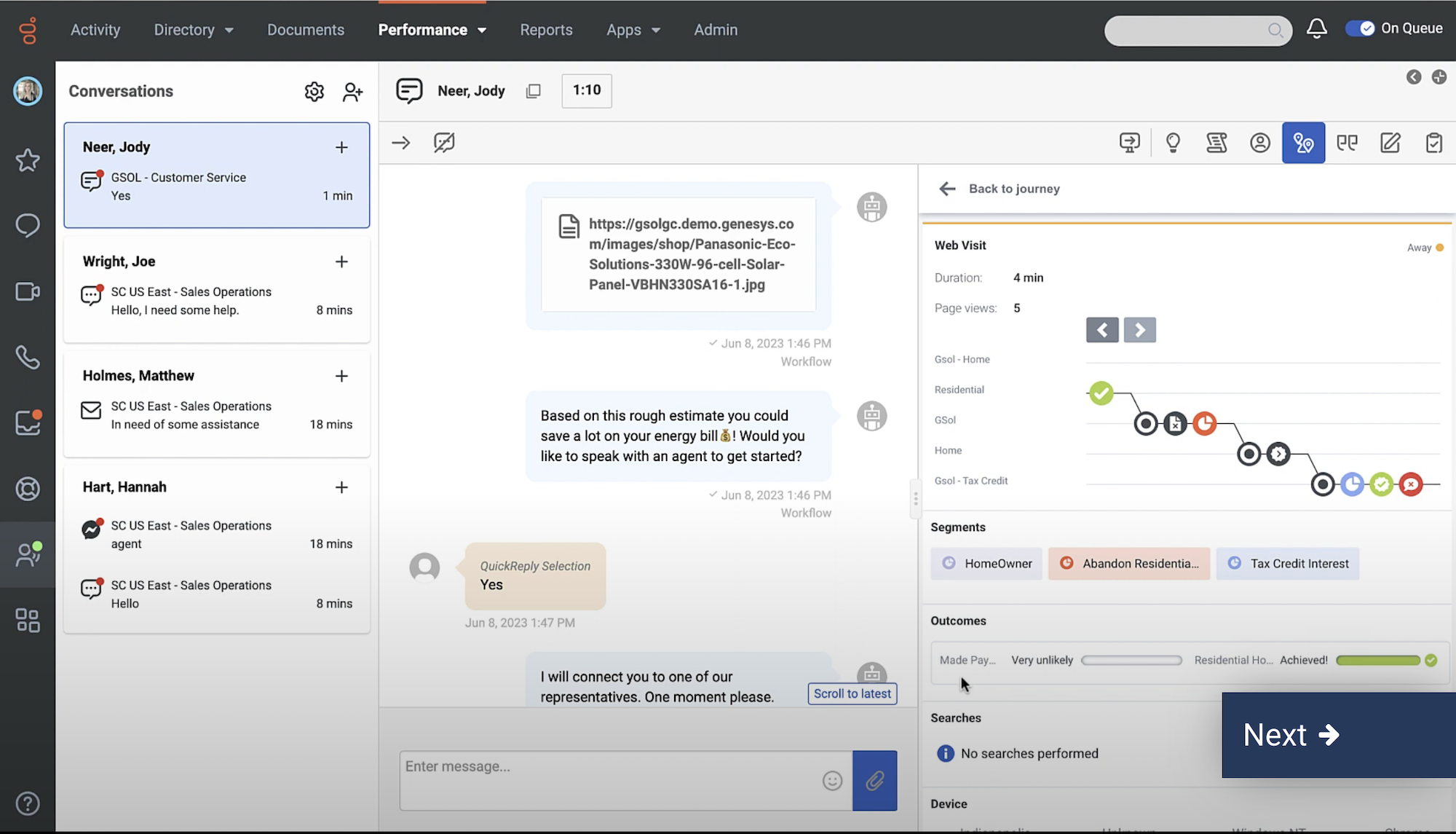
Genesys Cloud
Shared Customer Engagement features:
- Voice Calling: Unlimited VoIP calling, voicebots/IVAs, smart call routing, call recording, automated callbacks, inbound/outbound IVR, and SMS texting. Also includes outbound auto dialers with progressive, preview, and predictive dialing modes
- Digital Channels: Live agent:customer and bot-based communication across dozens of digital channels including website chat, social media messaging, WhatsApp, and email. Both providers offer agent-customer co-browsing in real-time.
- Chatbots: 24/7 Conversational AI chatbots proactively engage with website visitors at the ideal moment in the customer journey based on historical data and machine learning. Chatbots automatically collect and store customer data, and can escalate complex support interactions to the best available live agents via predictive omnichannel routing. Genesys and NICE users can import existing chatbots or build their own.
- Omnichannel Campaign Management: Besides voice calling campaigns, both providers offer automated SMS and email marketing campaigns. Campaign management features include lead list management/scrubbing, lead qualification and segmentation, automated TCPA compliance, and auto follow-ups/re-engagement.
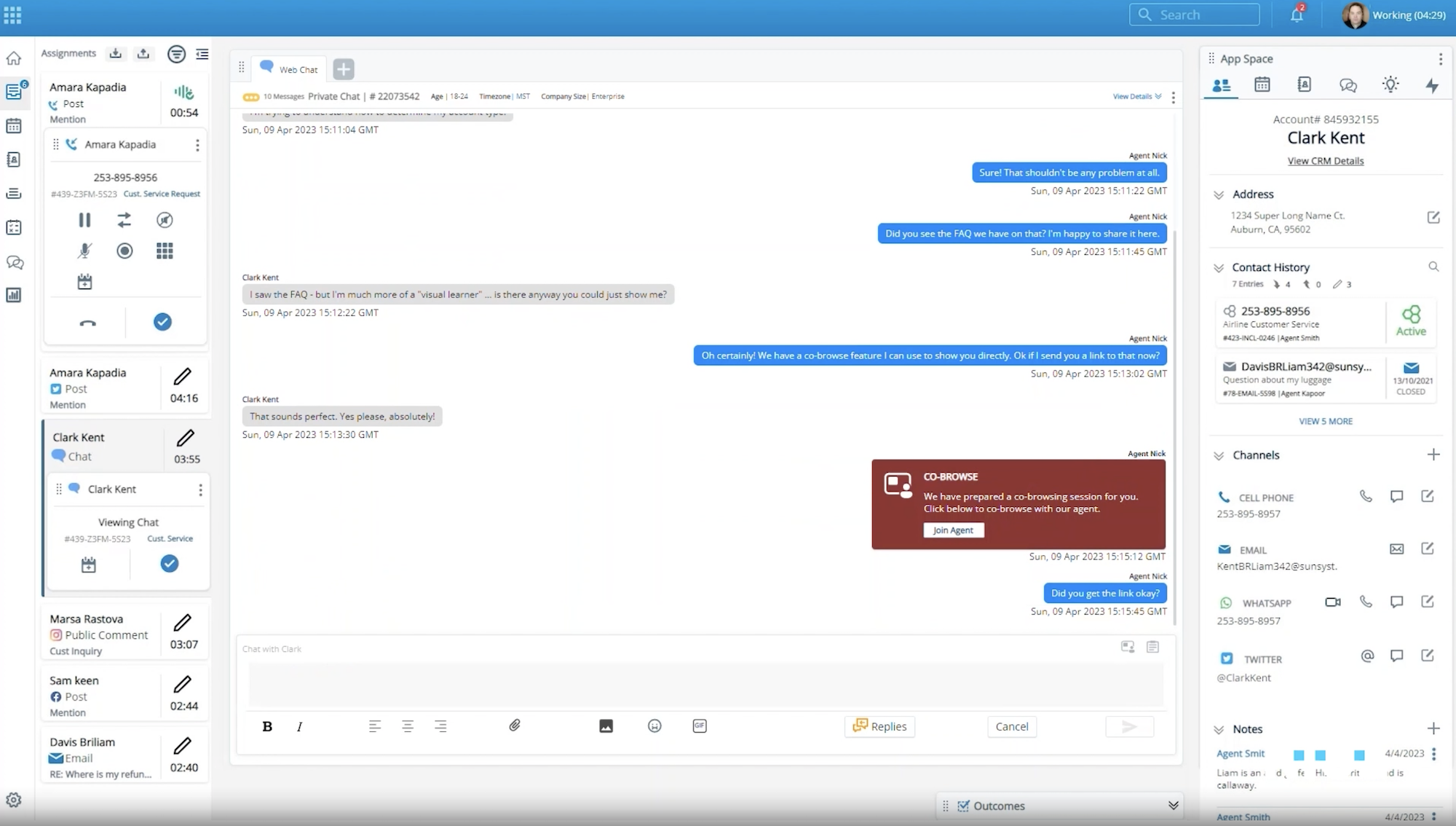
NICE CXone
Differences in Customer Engagement features:
- NICE offers voicemail drop for auto dialers, Genesys does not
- NICE proactive chatbots give customers tailored product/service promotions and relevant knowledge base articles
- Genesys provides more advanced email features than NICE, including smart email routing, agentless emailing, and email campaign management
Agent Assist
Key Takeaway: NICE’s Agent Assist feature notifies agents of potential compliance risks and automatically guides customers through complex, multi-step support processes. Genesys’s Agent Assist feature collects and acts on agent feedback regarding AI-generated responses and provides wrap-up code predictions.
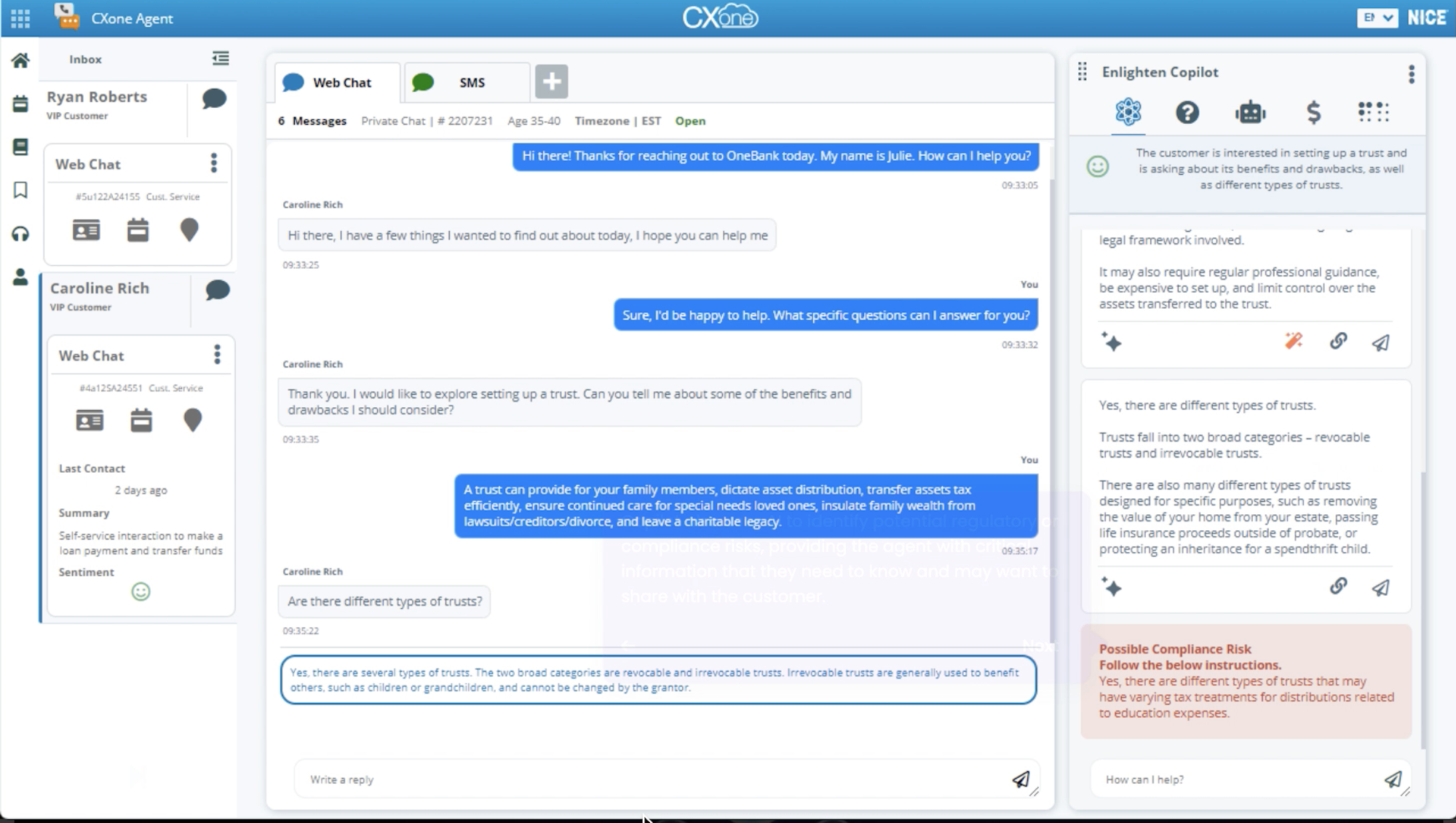
NICE CXone
Shared Agent Assist features:
- Works across voice and digital channels
- Real-time next-best-action suggestions powered by GenAI
- Internal knowledge base integration and management
- Automated post-interaction summaries
- Collects customer sentiment, intent, and satisfaction data
- Canned responses and complete agent scripts
- Real-time speech-to-text transcription for voice calls
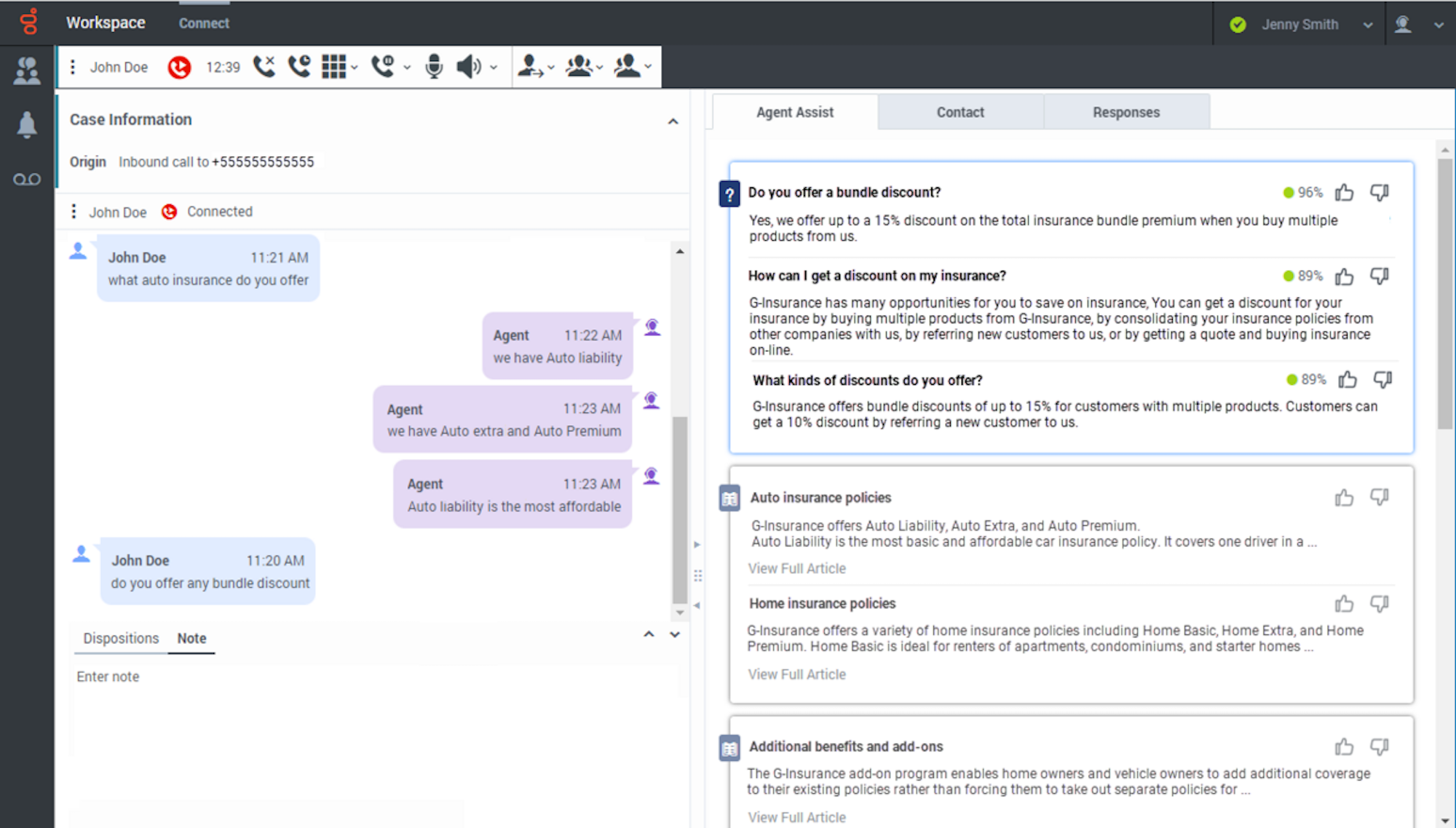
Genesys Cloud
Differences in Agent Assist features:
- Genesys lets agents edit automated interaction summaries to add their own notes
- NICE lets agents see what customers have searched for in the knowledge base, and which articles they’ve already read, to prevent repetition
- Genesys Agent Assist is available in multiple languages to support international customers
- NICE provides automated compliance risk alerts
Workforce Management Tools
Key Takeaway: While NICE CXone WFM features provide more advanced forecasting and scheduling tools, Genesys excels at agent coaching and performance gamification.
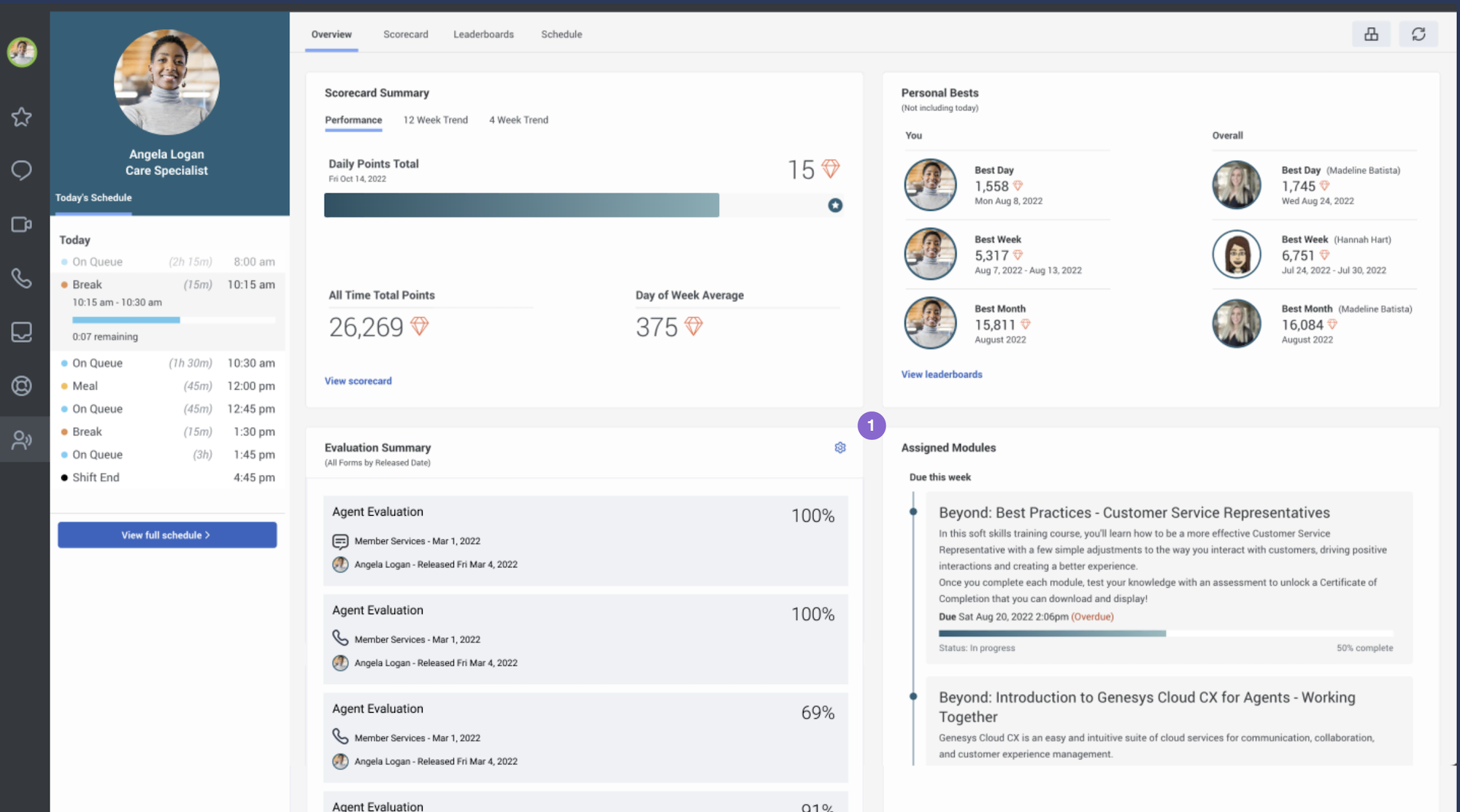
Genesys Cloud
Shared WFM features:
- Performance Management: Both Genesys and NICE offer real-time KPI alerts, performance gamification via leaderboards/wallboards, employee recognition tools, customizable agent scorecards, time utilization reports, real-time adherence monitoring, 1:1 agent coaching, training module assignments
- Quality Management: NICE and Genesys offer omnichannel interaction recording and agent screen recording with custom retention/recording rules. Both providers offer real-time interaction monitoring with call whisper/live chat coaching, Voice of the Customer feedback (surveys), and advanced customer sentiment analysis
- Forecasting+Scheduling: Both platforms offer advanced forecasting tools, powered by predictive analytics, to optimize long and short-term workforce planning/agent scheduling. Agents can view their schedules, request PTO, and trade shifts directly in the WFM interface for desktop and mobile devices. Both providers offer real-time adherence monitoring and automated workflows
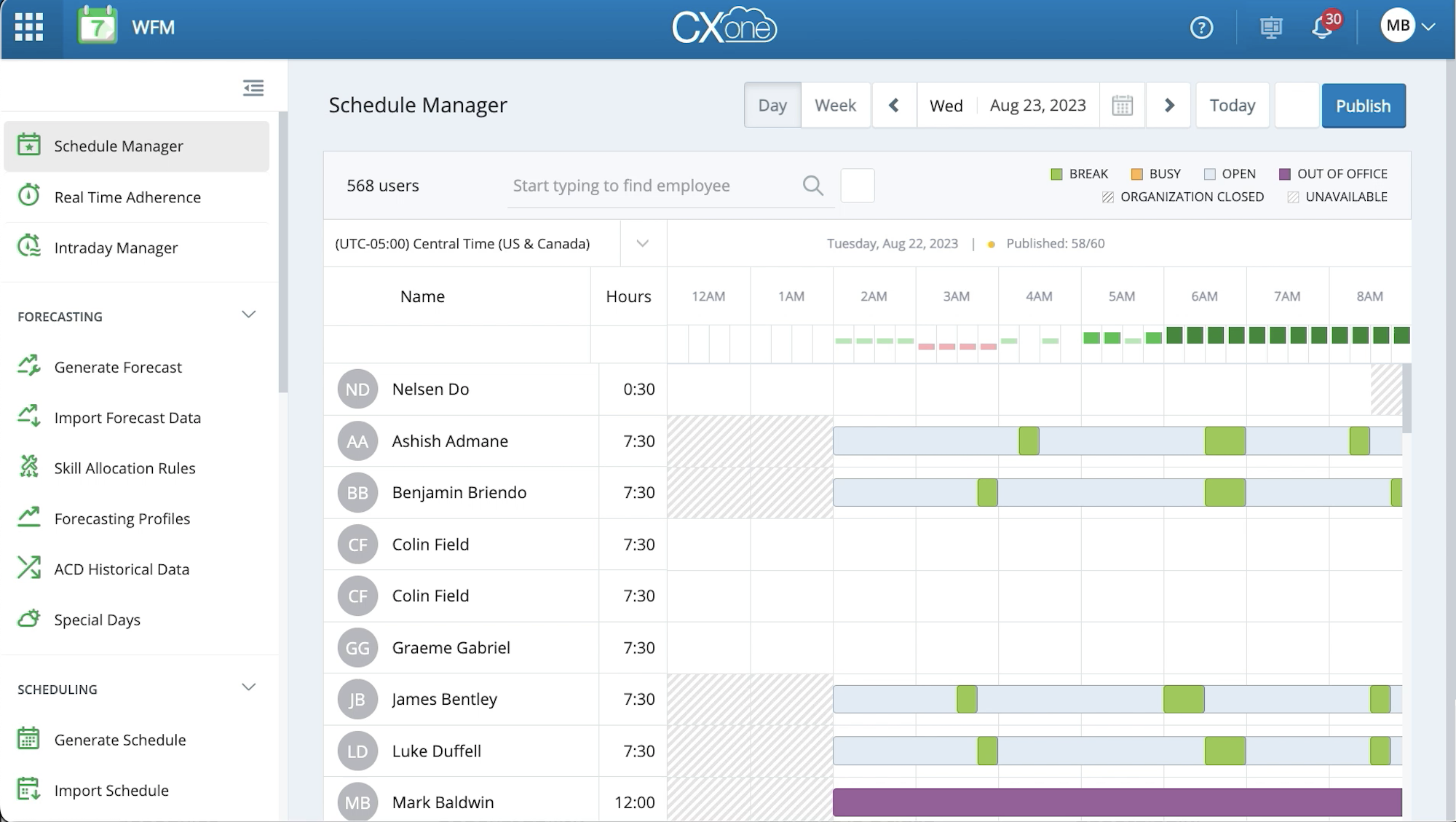
NICE CXone
Differences in WFM features:
- Genesys includes a “personal best” gamification feature that lists an agent’s “personal best” KPIs and scorecards for the day, week, or month–then compares their personal bests to those of other agents within the performance monitoring interface
- NICE CXone includes employee self-assessment forms plus agent “appeals” (quality management disputes) that allow agents to contest low scores and explain their side of the story to management
- NICE provides more advanced forecasting tools than CXone and has over 40 algorithms to choose from. NICE forecasting features include best-pick technology, exponential smoothing, and custom parameters for “what-if” scheduling
Analytics+Reporting
Key Takeaway: Genesys and NICE have AI-powered reporting tools offering high-level insights into real-time and historical agent activity and customer behavior, but NICE provides more detailed contact center analytics overall. Genesys includes customer interaction, call center activity, and customer experience analytics designed to streamline customer journeys and improve agent performance. NICE CXone includes interaction analytics, Enlighten Actions, contact center reporting, omnichannel feedback management, and business process analytics designed to identify more opportunities for automation and improve CX.

NICE CXone
Shared analytics features:
- Speech and Text Analytics: Geneys and NICE monitor 100% of omnichannel customer interactions to identify common support topics, evaluate agent skill sets and performance, conduct root cause and customer sentiment analysis, and score agent empathy
- Customer Survey/Feedback Analysis: Both providers include an omnichannel customizable survey builder with real-time VOC reporting, CSAT/NPS monitoring, and performance feedback for individual agents
- Contact Center Analytics: Both providers conduct customer journey mapping and funnel analyses, send custom contact center KPI alerts, monitor real-time and historical call transfer rate, and perform interaction recording/transcription with agent screen recording. Additional shared analytics include task tracking, FCR, AHT, call abandonment rate, adherence monitoring, and transfer rate analysis
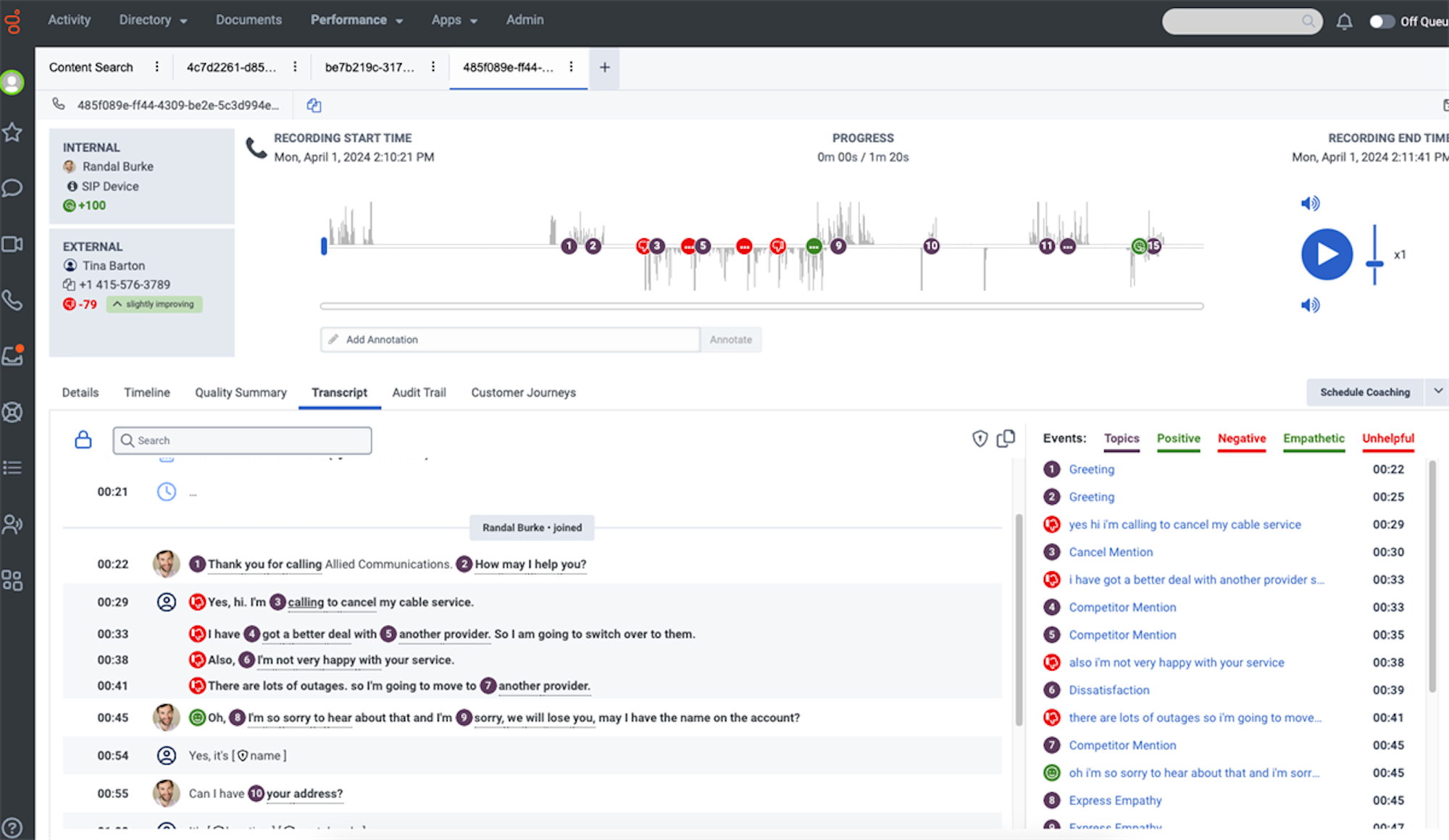
Genesys Cloud
Differences in analytics features:
- While Genesys offers only 30+ pre-built reporting templates, NICE CXone includes 90+ pre-made templates including agent time utilization reports and routing summaries
- CXone Enlighten Actions lets managers type questions like “What are the top ten customer service call reasons?” directly into the interface, then review detailed AI-powered answers that include conversational analysis, data visualizations, summaries, and drilled-down, color-coded statistics. Managers can also review automation suggestions, further customize reports via conversational AI, and use AI-generated training materials based on findings
- Genesys Agent Empathy feature uses AI to evaluate agent soft skills, identifying “helpful, unhelpful, positive, negative, and empathetic” sentiments during customer conversations. Each identified emotion is time-stamped and labeled, admins can filter findings by emotions, and view each agent’s overall empathy score
Genesys Cloud vs NICE CXone: User Experience
Below, we outline top Genesys Cloud and NICE CXone pros and cons.
Genesys Pros
- Agent Workspace: Intuitive agent workspace gives reps instant, in-conversation access to essential CRM data, agent notes, omnichannel interaction history, canned responses, scripts, Agent Assist next-best-action suggestions, and customer journey maps. Agents can share their screens directly with customers, access “quick actions” like one-click ticket management/transfer, and review personal KPIs, performance scorecards, and assigned coaching modules in-dashboard.
- Team Collaboration: Genesys unified communications/collaboration tools like public/private chat, HD video calling, file sharing, agent status updates, and a unified company directory eliminate communication silos and increase productivity.
- Bot Flow Builder: Create an unlimited number of low-code voicebots and chatbots with the drag-and-drop bot flow builder, add rich communication services (image carousels, etc.) to bots, import existing bots, set custom bot rules, and access bot templates. Enhance bots further with real-time customer sentiment analysis, customer recognition via IP address, and utterance predictions.
Genesys Cons
- Limited Reporting: Genesys Cloud offers limited analytics and reporting features compared to competitors–especially when it comes to customizable reports. The reporting tools they do include are difficult to navigate, making finding actionable insights challenging and time-consuming.
- Online Knowledge Base: Genesys’ online knowledge base and product documents do not contain sufficient information about specific features and platform capabilities, meaning it’s difficult to get a straightforward answer about what Genesys can and cannot actually do. Much of the information in the knowledge base is outdated, leads to broken links, or has been removed altogether–making self-service almost impossible even for tech-savvy users.
- Employee Scheduling: Employee forecasting and scheduling tools are buggy and not intuitive, leading to an increase in agent absenteeism or over-scheduling during the onboarding process
NICE CXone Pros
- WFM Tools: NICE easily has some of the best workforce management, scheduling/forecasting, and performance monitoring tools in the CCaaS space–especially ideal for remote/blended teams needing assistance with agent optimization
- AI Analytics: Users can access conversation-based insights about real-time and historical contact center trends, making it easy to identify the root causes of customer journey bottlenecks and improve CX as a whole
- Scalability: NICE has flexible pricing tiers and a variety of individual add-ons that help users avoid paying for excessive features they won’t use. NICE’s pricing tiers provide support for contact centers during every phase of business, including via digital-only or voice-only solutions.
NICE CXone Cons
- Collaboration Tools: NICE CXone does not include native collaboration tools (team chat, video calls, etc.) and requires users to integrate with Microsoft Teams to access unified communications functionality–a glaring omission in an otherwise feature-rich platform.
- Call Quality: Despite its 99.99% uptime, NICE users experience frequent dropped calls and latency, degrading the customer experience and increasing call times.
- Lengthy Onboarding: While NICE provides excellent online resources like webinars and tutorials, it’s still a complex platform with advanced functionalities that lead to a longer onboarding process than competitors.
Use NICE CXone If You Need:
- An enterprise-grade CCaaS platform that leverages AI to lower operating costs, optimize available agents, and provide 24/7 omnichannel customer service
- AI-enhanced workforce management and performance monitoring tools to help improve CSAT levels, increase FCR, and decrease agent attrition
- A digital-first contact center that seamlessly streamlines communication across at least 5 digital channels and engages customers across multiple social media platforms
- Advanced AI-powered analytics that identify opportunities for automation and provide long-term strategic planning advice
Use Genesys Cloud If You Need:
- Omnichannel outbound marketing and campaign management tools to increase conversions, segment consumer markets, and proactively engage/re-engage customers at the ideal time
- High-level, pre-built integrations and APIs that allow you to continue using existing third-party tools directly in the Genesys interface
- An enterprise contact center solution with built-in team collaboration tools, like video conferencing and team chat messaging
- A WFM+CCaaS tool that helps improve agent soft skills like empathy and active listening, while providing detailed customer interaction analytics

